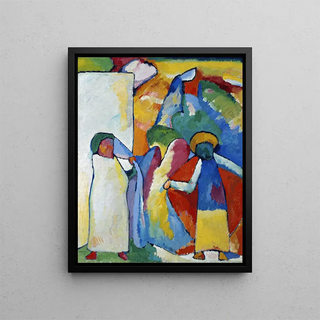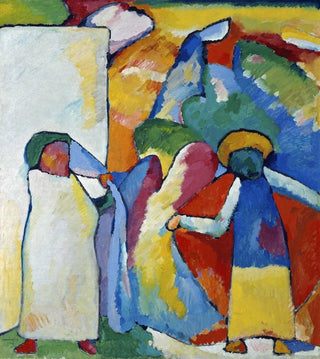Art print | Improvisation 6 African - Wassily Kandinsky


View from behind

Frame (optional)
Wassily Kandinsky’s "Improvisation 6 African" stands as a true ode to abstraction, immersing viewers in a vibrant universe of colors and shapes. Created in 1910, this canvas embodies the artist’s desire to transcend the material world and reach a spiritual dimension. Through this work, Kandinsky does not merely depict elements of the visible world; he seeks to express pure emotions and sensations, fostering a dialogue between art and the soul. His bold and innovative approach marked a turning point in the history of modern art, establishing him as one of the pioneers of abstract art.
Style and uniqueness of the work
"Improvisation 6 African" is distinguished by its daring use of color and shapes. Bright, dynamic hues intertwine, creating a composition that seems to vibrate and pulse before the viewer’s eyes. Geometric and organic forms intertwine, evoking both nature and imagination. This blend of styles reflects the influence of African arts, which Kandinsky deeply admired. The way he overlays elements without seeking to rationalize them demonstrates his desire to free art from traditional constraints. Every brushstroke, every shade of color, is an invitation to feel rather than understand, to dive into an ocean of emotions where logic has no place.
The artist and his influence
Wassily Kandinsky, born in Russia in 1866, is often regarded as the father of abstract art. His artistic career is marked by an unceasing quest for spirituality through painting. Influenced by music, he aimed to create a visual harmony comparable to sound compositions. His work is set against a rich historical context, between the rise of avant-garde movements and social upheavals of his time. By founding the Bauhaus movement and participating in numerous exhibitions, Kandinsky played a crucial role in spreading modern art. His impact still endures today, inspiring generations of artists to explore the boundaries of abstraction and to express their emotions.

Matte finish

View from behind

Frame (optional)
Wassily Kandinsky’s "Improvisation 6 African" stands as a true ode to abstraction, immersing viewers in a vibrant universe of colors and shapes. Created in 1910, this canvas embodies the artist’s desire to transcend the material world and reach a spiritual dimension. Through this work, Kandinsky does not merely depict elements of the visible world; he seeks to express pure emotions and sensations, fostering a dialogue between art and the soul. His bold and innovative approach marked a turning point in the history of modern art, establishing him as one of the pioneers of abstract art.
Style and uniqueness of the work
"Improvisation 6 African" is distinguished by its daring use of color and shapes. Bright, dynamic hues intertwine, creating a composition that seems to vibrate and pulse before the viewer’s eyes. Geometric and organic forms intertwine, evoking both nature and imagination. This blend of styles reflects the influence of African arts, which Kandinsky deeply admired. The way he overlays elements without seeking to rationalize them demonstrates his desire to free art from traditional constraints. Every brushstroke, every shade of color, is an invitation to feel rather than understand, to dive into an ocean of emotions where logic has no place.
The artist and his influence
Wassily Kandinsky, born in Russia in 1866, is often regarded as the father of abstract art. His artistic career is marked by an unceasing quest for spirituality through painting. Influenced by music, he aimed to create a visual harmony comparable to sound compositions. His work is set against a rich historical context, between the rise of avant-garde movements and social upheavals of his time. By founding the Bauhaus movement and participating in numerous exhibitions, Kandinsky played a crucial role in spreading modern art. His impact still endures today, inspiring generations of artists to explore the boundaries of abstraction and to express their emotions.






